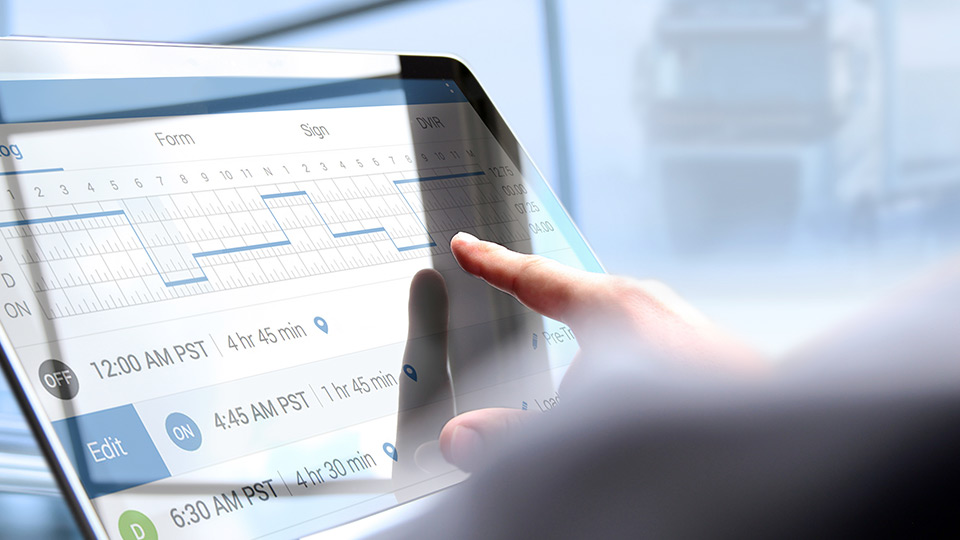
How to build a fleet safety program – A step-by-step guide
Last updated on May 13, 2024 in Driver Safety by Geotab Team | 4 minute read
Table of contents
- What is a fleet safety program?
- How to build your fleet safety program
- Set up a fleet safety council
- Why a fleet safety council is important
- Monitor policy compliance with fleet rules
- Hold your team accountable
- Stay up-to-date on fleet maintenance
- Create fleet safety benchmarks
- Leverage fleet safety analytics - powered by AI
- Analyze fleet safety benchmark metrics
- Take action on your fleet safety today
Set up your fleet for success with this guide to building a best-in-class fleet safety program.
A best-in-class fleet safety program starts with a core team of people who are committed to safety, combined with regular training and a written policy that is consistently communicated and enforced. Benchmarking can also be used to improve performance.
What is a fleet safety program?
A fleet safety program is a comprehensive plan that businesses implement to ensure the safety of their fleet operations. The program will typically include policies, procedures, and practices designed to minimize risks associated with vehicle use, improve driver safety, and reduce the likelihood of collisions. Key components often include driver training and education, regular vehicle maintenance, and the use of technology to monitor and improve driver performance.
Why is a fleet safety program important?
A thorough fleet safety program is important because it helps protect a company’s most valuable assets—its employees and vehicles. Beyond keeping drivers safe, a well-executed fleet safety program can greatly reduce costs associated with accidents, such as repairs, legal fees, and insurance premiums. Promoting a culture of safety increases overall productivity by minimizing vehicle downtime and fostering responsible driving behaviors, which also improves public safety.
How to build your fleet safety program
Set up a fleet safety council
Creating a fleet safety council or dedicated team is a best practice for any business or organization. The safety council can meet on a regular basis, at least monthly, to analyze all collisions — both preventable and unpreventable — as well as all exceptions outlined in the fleet safety policy.
Team members could include the fleet manager, and, preferably, a member of Human Resources. Depending on the seriousness of the policy violation, this core group may include the driver's managers or even a member of the company’s legal team.
Implementing a driver feedback program can further enhance the effectiveness of your fleet safety initiatives. By establishing channels for drivers to share their insights and concerns, businesses can identify potential safety issues before they escalate. Proactive communication encourages a culture of safety and inclusion, so drivers feel valued and heard. Regular feedback sessions, combined with real-time data analytics, enable fleet managers to fine-tune their strategies and address specific areas that need attention.
Why a fleet safety council is important
The main goal of a safety council is to keep track of all infractions and to consider any appeals filed by drivers who believe they have been unfairly penalized. This group would also make sure that the policy is communicated properly and frequently, and that it is followed consistently and fairly at all levels of the business.
One of the worst things that could happen to a company with a policy that is not consistently and fairly enforced or maintained, is that it would impact them significantly in a court of law. A lack of a policy in general is also not ideal. Both of these scenarios could be financially damaging to a company and their brand and reputation.
Monitor policy compliance with fleet rules
A good process is to manage by exception. This means that fleet managers should be spending most of their time focusing on issues that have the greatest influence on the company’s bottom line — like dangerous driving habits. Using a pre-built driver safety scorecard, like the one available from the Geotab Marketplace, makes it easier to set up rules to measure each part of the safety policy and then send reports to the appropriate managers or teams.
Dash cams are an invaluable tool for modern fleet safety programs. By recording real-time footage, these devices provide irrefutable evidence in the event of an incident, which helps streamline the resolution process. More importantly, dash cams serve as a deterrent against unsafe driving practices, encouraging drivers to adhere to safety protocols. The visual data collected can also be used for coaching and training purposes, offering drivers tangible insights into their driving habits and areas for improvement.
Hold your team accountable
It is vital to have defined responsibilities of accountability for report action items and timelines for those actions to better change and manage driver behavior as well as safeguard your company.
From a solution standpoint, there are a variety of options for accountability depending on the job, as well as the company's culture and safety focus. Companies of all types should have a solution in place, whether internal or external, that documents all actions and events related to safety policy management, as well as someone who assigns and tracks driver training for exception behavior.
Requiring an annual driver training refresher and policy reinforcement program is also a good way to maintain informed employees and a best-in-class fleet.
Stay up-to-date on fleet maintenance
In addition to promoting a culture of accountability, regular fleet maintenance is essential for ensuring the safety and reliability of any fleet. Establishing a stringent maintenance schedule helps prevent mechanical failures that could lead to accidents. This involves routine checks and timely repairs of essential components such as brakes, tires, and lights. Effective fleet maintenance not only promotes safety but also optimizes vehicle performance and extends the lifespan of your fleet, to support a sustainable operational model.
Create fleet safety benchmarks
A good technique for analyzing and optimizing operations based on a fleet's driving habits is fleet benchmarking. This method allows you to assess your current fleet performance and track your progress toward your objectives by comparing your data to that of other fleets.
Through the use of telematics, fleet managers can collect a significant amount of data from a number of sources, create unique fleet goals and make appropriate adjustments to their fleet operations based on industry standards.
Benchmarking knowledge provides a firm platform for decision-making. When you compare your performance to others in your field, you can see where you're falling short and where you might improve.
Leverage fleet safety analytics - powered by AI
Geotab’s new Safety Benchmarks experiment, available in the Analytics Lab, provides fleet managers with actionable insights by analyzing their fleet’s safety performance, and comparing it to peer groups.
Unlike typical benchmarking calculations that depend on surveys, this one leverages artificial intelligence (AI). Geotab’s benchmarking analysis takes an AI-driven approach to dynamically create peer groups, helping fleet managers make data-driven decisions.
To learn more about Geotab’s available Analytics Lab experiments, read: Improve how your fleet runs with the Analytics Lab.
Analyze fleet safety benchmark metrics
The Safety Benchmarks experiment provides fleet safety scores for overall performance as well as by event types like Harsh Braking and Acceleration. Moreover, our benchmarking analysis looks at various data points that indicate unique characteristics of a fleet’s profile such as vocation, vehicle composition and more, in order to create peer groups for your fleet.

Figure 1: A sample of a safety benchmark metrics report from the Analytics Lab in MyGeotab.
Take action on your fleet safety today
To see how your current fleet safety program measures up, we invite you to use Geotab’s Safety Grader. This tool will help you evaluate your fleet’s safety performance and identify areas for improvement based on industry benchmarks.
If you liked this post, let us know!
Disclaimer
Geotab's blog posts are intended to provide information and encourage discussion on topics of interest to the telematics community at large. Geotab is not providing technical, professional or legal advice through these blog posts. While every effort has been made to ensure the information in this blog post is timely and accurate, errors and omissions may occur, and the information presented here may become out-of-date with the passage of time.
Get industry tips and insights
Sign up for monthly news and tips from our award-winning fleet management blog. You can unsubscribe at any time.
Other posts you might like
.jpg)
Working Together to Raise Distracted Driving Awareness: Driving Safely in a Connected World
April 23, 2024

ELD self-certification: What you need to know
April 10, 2024

Geotab 2024 discussion recap: A Data-Driven Journey in Fleet Maintenance
March 11, 2024

How a Domino’s Pizza franchisee saves $100,000 per year
February 28, 2024





